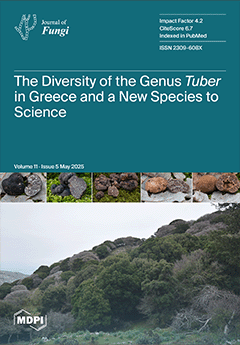With the continuous change of climate, drought stress has emerged as the primary constraint on crop growth, posing a significant threat to the stability of global grain reserves. Arbuscular mycorrhizal fungi (AMF), as a kind of widely distributed root endophytes, enhance the drought tolerance of maize (
Zea mays L.) through regulating the physiological and molecular responses. However, comprehensive transcriptome analysis to reveal the molecular mechanism of drought tolerance in the symbiotic process between AMF and maize is still limited. In the potted plant experiment, maizes inoculated with and without arbuscular mycorrhizal fungus
Funneliformis mosseae were grown under well-watered (WW) or drought-stressed (DS) conditions. By using RNA-Seq and transcriptome analysis on maize roots and leaves, this work aimed to investigate the differential expressed genes (DEGs) related to the Ca
2+ signaling pathway induced by AMF symbiosis under drought stress. Our findings indicated that
F. mosseae inoculation resulted in a decrease in the net fluxes of Ca
2+, while simultaneously elevating Ca
2+ contents in the maize roots and leaves under well-watered or drought-stressed conditions. Notably, 189 DEGs were regulated not only by AMF symbiosis and drought stress, but also exhibited preferential expression in either leaves or roots. The annotation and enrichment of Gene Ontology (GO) and Kyoto Encyclopedia of Genes and Genomes (KEGG) showed that most of the DEGs were significantly enriched in Ca
2+ signaling pathway genes, related to signal transduction, cellular process, and defense response. A high number of DEGs with this function (including calcineurin B-like protein (CBL), CBL-interacting protein kinase (CIPK), mitogen-activated protein kinase (MAPK), and calcium-dependent protein kinase (CDPK) receptor kinases) were upregulated-DEGs or downregulated-DEGs in
F. mosseae-inoculated maizes under drought stress. Furthermore, some DEGs belong to transcription factor (TF) families, including bHLH ERF, and, MYB, were speculated to play key roles in improving the drought tolerance of maize. Based on the expression data and co-expression analysis between TF and Ca
2+ signaling pathway genes,
Whirly1 with
CBL11, and BRI1-EMS-SUPPRESSOR 1 (
BES1) with
CBL10,
CIPK24,
CDPK1,
CDPK14,
CDPK19, and
MAPK9 genes showed significant positive correlations, while
B3 domain-containing transcription factors (
B3 TFs) with
MAPK1 and both
CBL9 genes showed significant negative correlations in response to both
F. mosseae inoculation and drought stress. The regulation of Ca
2+ signaling pathways by AMF symbiosis was an important response mechanism of maize to improve their drought resistance. This study provides insightful perspectives on how AMF-induced modulation of gene expression within the Ca
2+ signaling pathway can enhance the drought tolerance of mycorrhizal maize in the future.
Full article






